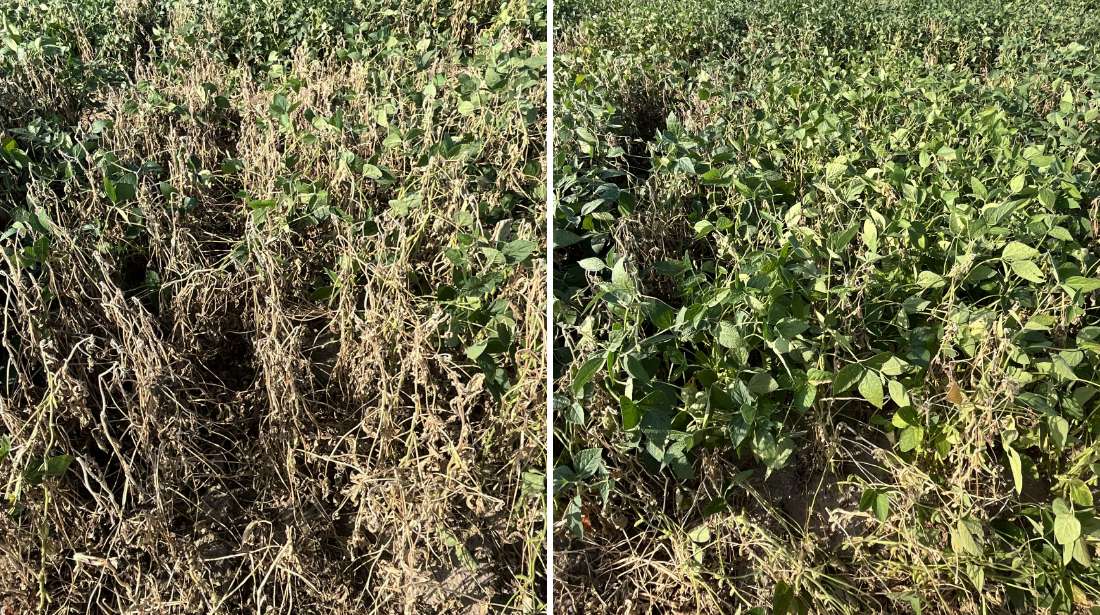The July 8, 2024, Crop Progress Report from the National Agricultural Statistics Service states 34% of the country’s soybeans are blooming, with 9% setting pods. So, now is an ideal time to scout for soybean white mold.

“From floods in the Midwest to hurricane precipitation in the South, high levels of moisture and humidity are a recipe for soybean diseases like white mold,” says Tyler DuBay, soybean technical agronomist for Stine· Seed Company.
White mold, also known as Sclerotinia stem rot, is a devastating crop disease, causing upward of 10% bushel per acre yield loss each year. Currently, we are within the flowering window for early planted crops, so there is little growers who planted early can do to minimize yield damage. However, for those who planted later, you can mitigate the disease with multiple options. All growers can take advantage now to better control its incidence in 2025.
What are the symptoms of white mold on soybeans?
To recognize soybean white mold symptoms, it’s important to understand the evolution of the disease in a crop.
White mold is caused by the fungus Sclerotinia sclerotiorum and begins its life cycle underground as sclerotia. Usually left behind by the previous year’s crop, sclerotia can live in soil for several years. It eventually germinates into mushrooms called apothecia, which thrive in moist, cool environments and proliferate after canopy closure. Each apothecium can produce up to one million spores and infect neighboring soybean plants. Once a plant is infected, the fungus will typically first display symptoms around the R3 to the R6 growth stage, where gray to white lesions form at the nodes of the plant. As the disease progresses, the fungus produces fluffy, white, cotton-like mycelial on the stems.
Once white mold takes hold of the plant, it can experience stem rot, flower wilt, leaf death and the eventual death of the entire plant.
How to treat white mold in soybeans
Scouting for soybean white mold symptoms is important this time of year. It's especially timely to scout for lesions, and it's also a good time to open the canopies for flowering to reduce impact.
“There are some soybean white mold treatments available in-season, like fungicides and biologicals, but growers must know exactly when to apply them, and, most importantly, how to plan ahead for next year."
Tyler DuBay, Stine soybean technical agronomist
Here are a few considerations for managing white mold.
When to spray for white mold in soybeans?
If growers decide to take an in-season fungicide approach, it’s best to make applications between the R1 and R3 growth stages. Experts from Michigan State University Extension note historically, applications at R1, when there’s one open flower per plant on half of the plants, are recommended. Research has also shown applications at the R2 growth stage can render results.
Harvest considerations
White mold can easily spread to new fields when harvest equipment is not properly cleaned. Experts recommend waiting to harvest areas where white mold is present last. If that isn’t possible, thoroughly clean your equipment before heading into an unaffected field.
Planning for next year
Crop rotation can lower the incidence of white mold in a field.
“Broadleaf crops are susceptible to white mold; others like corn and small grains are not,” says DuBay. “If growers rotate away from soybeans for one or even two years, they help rid the field of sclerotia.”
According to experts from Michigan State University Extension, when a non-host crop is planted, sclerotia can still germinate but no infection should occur, essentially terminating the life cycle of the disease.
Variety selection is also important. Some soybean varieties are more susceptible to white mold under certain conditions and environments. It is critical to have conversations with your sales rep about variety performance within our disease trials.
“Stine has several varieties for the 2025 planting season that have strong tolerance to white mold,” notes DuBay. “We also have access to seed treatments to help prevent infection.”
Planting configuration is critical in white mold prevention, too. DuBay recommends planting in wider rows next year if the disease is present this year to allow more air movement between rows.
“You don’t want stale air in your canopy,” says DuBay. “If you can get wind movement in the rows but still have some good shade from the canopy, you will reduce white mold.”
Growers can also leverage apps like Sporecaster — the white mold forecaster — and Field Prophet to help predict their risk of the disease now and in the future.
To learn more about scouting for soybean diseases like white mold and white mold prevention strategies, contact your local university extension expert or Stine agronomist. Your Stine sales rep can also direct you to the right products for next year.
Related Articles
-

Stine® to offer Syngenta’s Victrato® soybean seed treatment in 2026
December 2025 in Agronomy
-

Use Stine’s XP® seed treatments to prevent early injury to your crops
December 2025 in Agronomy
-

Understanding Stine’s enhanced oil profile soybeans
December 2025 in Agronomy
-

Soil sampling sets the stage for spring
November 2025 in Agronomy



